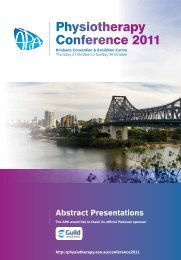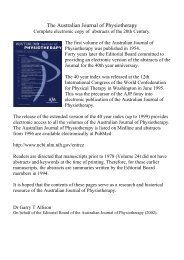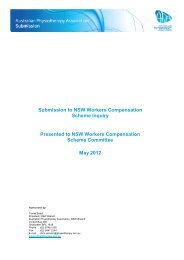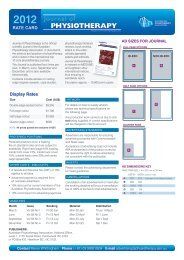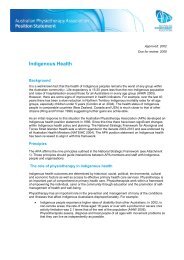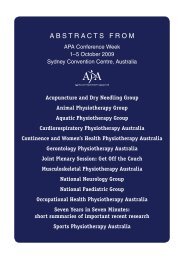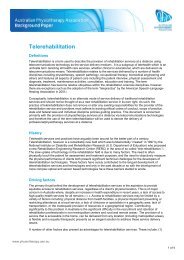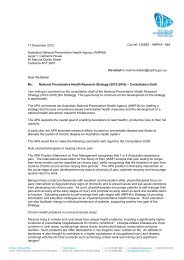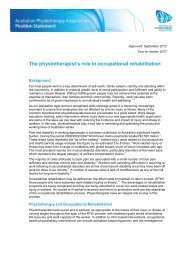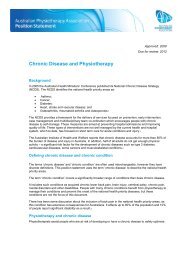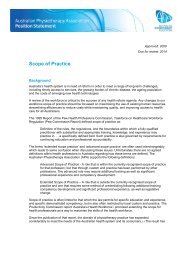The Australian Journal of Physiotherapy
The Australian Journal of Physiotherapy
The Australian Journal of Physiotherapy
You also want an ePaper? Increase the reach of your titles
YUMPU automatically turns print PDFs into web optimized ePapers that Google loves.
<strong>The</strong> characteristics and biologic effects <strong>of</strong> ultrasound and general principles <strong>of</strong> application including<br />
indications and contraindications are reviewed. Clinical application <strong>of</strong> ultrasound therapy and its<br />
use in diagnosis and research are discussed. <strong>The</strong> clinical use <strong>of</strong> ultrasound predominantly focuses<br />
on the field <strong>of</strong> rheumatology, with treatment effects obtained including relief <strong>of</strong> pain, improvement<br />
<strong>of</strong> flexibility and a decrease in muscle spasm.<br />
Keywords: Physical <strong>The</strong>rapy; Rheumatology; Ultrasonic <strong>The</strong>rapy<br />
Lind P (1955): <strong>The</strong> treatment <strong>of</strong> spinal paraplegia at Stoke Mandeville. <strong>Australian</strong> <strong>Journal</strong> <strong>of</strong><br />
<strong>Physiotherapy</strong> 1: 112-117.<br />
This article outlines a new approach to rehabilitation <strong>of</strong> the spinal paraplegic patient adopted at the<br />
English National Spinal Unit. This approach encompassed all staff at the unit, and centred around<br />
the principle that apart from paralysis <strong>of</strong> the lower body, a person with paraplegia in most cases is<br />
otherwise fit and able to be trained to almost absolute independence. A description <strong>of</strong> both medical,<br />
nursing and physiotherapy interventions to facilitate independence is given, focusing on<br />
physiotherapy techniques used in functional re-education, the prevention <strong>of</strong> contractures and the<br />
reduction <strong>of</strong> spasticity.<br />
Keywords: Paraplegia; Physical <strong>The</strong>rapy; Rehabilitation<br />
Murray AR (1955): Peripheral nerve injuries and their treatment. <strong>Australian</strong> <strong>Journal</strong> <strong>of</strong><br />
<strong>Physiotherapy</strong> 1: 120-124.<br />
<strong>The</strong> author presents a detailed description <strong>of</strong> the structural aspects and functional significance <strong>of</strong><br />
peripheral nerve injuries. Diagnostic issues, possibility <strong>of</strong> recovery and rate <strong>of</strong> regrowth specific to<br />
each <strong>of</strong> the three types <strong>of</strong> nerve lesions are noted. Aims and methods <strong>of</strong> physiotherapy interventions<br />
are discussed, with particular attention to the use <strong>of</strong> massage, splinting, mobilisation and muscle reeducation<br />
as modalities to provide an optimum environment for recovery and to facilitate the<br />
integration <strong>of</strong> returned movement into normal functional patterns. <strong>The</strong> primary importance <strong>of</strong><br />
physiotherapy in the management <strong>of</strong> causalgia and phantom limb pain is reviewed.<br />
Keywords: Movement Dysfunction; Nerve Tissue Injuries; Physical <strong>The</strong>rapy<br />
Duigan C (1955): Relaxation and natural childbirth. <strong>Australian</strong> <strong>Journal</strong> <strong>of</strong> <strong>Physiotherapy</strong> 1:<br />
127-130.<br />
<strong>The</strong> role <strong>of</strong> physiotherapy in childbirth is described as one which enables the mother to remove fear,<br />
use energy efficiently and cope with pain and difficulties encountered during labour. Prenatal<br />
exercises, a description <strong>of</strong> labour and techniques used by the mother during labour are presented.<br />
<strong>The</strong> advantages <strong>of</strong> relaxation in childbirth are outlined.<br />
Keywords: Labor; Pain; Physical <strong>The</strong>rapy; Prenatal Care<br />
Wedlick LT (1955): Recent advances in medical electricity. <strong>Australian</strong> <strong>Journal</strong> <strong>of</strong><br />
<strong>Physiotherapy</strong> 1: 152-157.<br />
Recent developments in the field <strong>of</strong> medical electricity are described, along with their<br />
corresponding values and limitations. Microwave treatment, ultrasonics, electrical stimulation <strong>of</strong><br />
denervated muscle, electrical testing <strong>of</strong> nerve lesions and electrophrenic stimulation are covered.<br />
<strong>The</strong> author considers ultrasonic therapy to have a clear biologic effect, but is best kept in reserve



